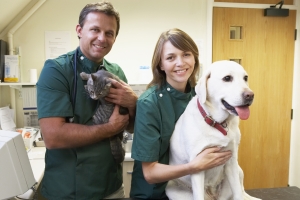 Accidents happen as well do complications associated with aging in both humans and animals; therefore, it is essential to know emergency CPR for dogs. If you do know know CPR we recommend taking a class at a local certified location not only will you have a sense of accomplishment you will be CPR certified. You might just end up saving a life.
Accidents happen as well do complications associated with aging in both humans and animals; therefore, it is essential to know emergency CPR for dogs. If you do know know CPR we recommend taking a class at a local certified location not only will you have a sense of accomplishment you will be CPR certified. You might just end up saving a life.
1. If you see a dog in trouble call an emergency animal hospital. If the dog appears unconscious first check if he/she is breathing. Look to see if the chest is moving. A dog takes on average 20-30 breathes a minute. After this put your face near the dog’s mouth to check for breathing. If he/she is breathing there is no need to for CPR; however, if there is no breathe proceed to step 2.
2. Quickly check for a heartbeat. Using your index and middle finger check for a heartbeat by placing these fingers on the bottom side of the dog’s wrist.
- You can also check the dogs heartbeat through his/her chest. Check with your hand and. A dog’s heart is located under the rib cage much like a persons, just on a smaller scale.
3. Check for an obstruction blocking his airway. Open the dog’s mouth and look to the back of his throat (use the light from your cellphone to help you see clearer) if there is something there remove it before performing CPR.
4. If the dog has a heartbeat you will want to concentrate on breathing for him/her.
- Position their head by tilting it back to where their head is aligned with their back this will open their airway (like you are positioning their head to look up at the ceiling)
5. Place your mouth over their airway. . If it’s a small dog, place your mouth over the dog’s nose and mouth. If it’s a large dog, place your mouth over the dog’s nostrils. Make sure to put pressure on the top of the dogs mouth, but you should put one hand on the bottom buy propecia online canada making sure their jaws are closed.
6. Begin to breathe for the dog. Blow firmly enough into the dog’s snout to lift the dog’s chest wall. If the chest rises easily (as is likely in a small dog), stop blowing once it has gently lifted. If you continue blowing, you may damage the dog’s lungs. Then release your lips to allow the air to escape.
- Aim for 20 – 30 breaths a minute, or one breath every 2 – 3 seconds.
 7. If the dog’s heart is not beating you must began chest compression after the breathing for him/her. Find the dog’s heart. Locate the heart by laying the dog on its side and swinging its front elbow back to the point where it meets the chest wall, which is where the heart lies. It is important to not be to rough as you can break a rib or cause more damage. But if you do break a rib in an older a frail dog, just keep going, the pet is better off with a broken rib then death. And when you are successful they will heal.
7. If the dog’s heart is not beating you must began chest compression after the breathing for him/her. Find the dog’s heart. Locate the heart by laying the dog on its side and swinging its front elbow back to the point where it meets the chest wall, which is where the heart lies. It is important to not be to rough as you can break a rib or cause more damage. But if you do break a rib in an older a frail dog, just keep going, the pet is better off with a broken rib then death. And when you are successful they will heal.
- A) Lay your palm over the heart and press down gently but firmly–use enough pressure to compress the chest to one-third or one-half of its depth. The compression is a quick, rapid movement: compress-release, compress-release, repeated 10 – 12 times around every 5 seconds.
- Give one artificial respiration breath and then repeat the cycle.
8.) Stop to access the situation. Stop every 2 minutes and check if the dog has resumed breathing for itself. If not, continue artificial respiration until help arrives.
It is scary to think you might have to perform this on your best friend, but at the same time it is better to be prepared. So if the time does arise when you need to perform CPR you will know what to do. For pictures and more step by step instructions check out wiki’s how to. (https://www.wikihow.com/Perform-CPR-on-a-Dog)
